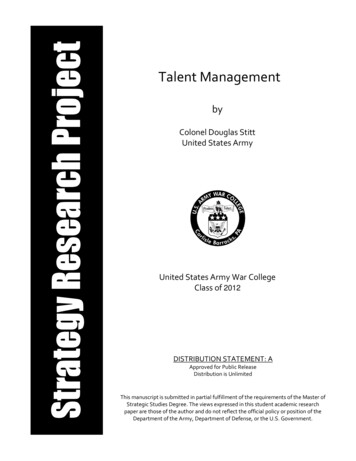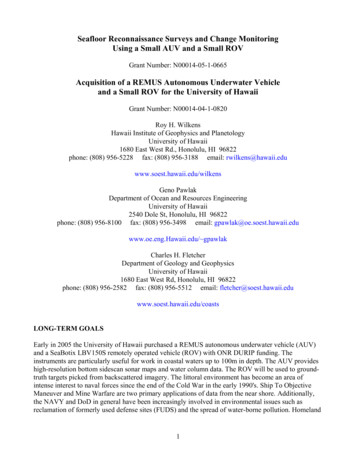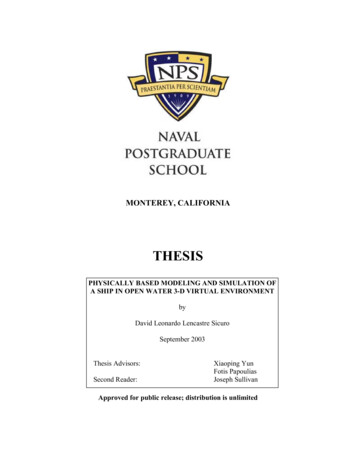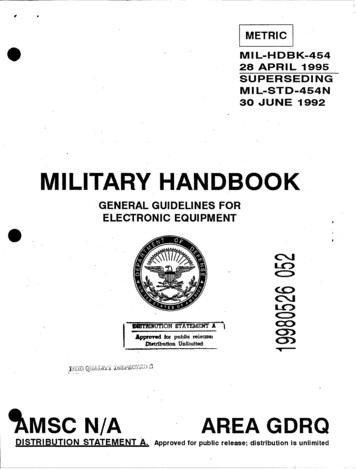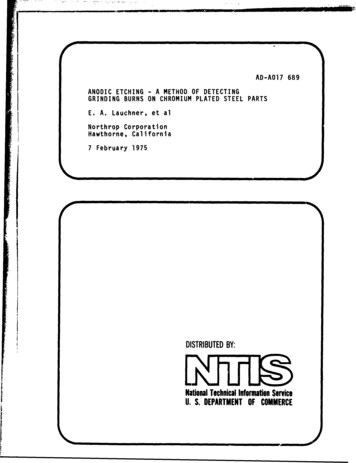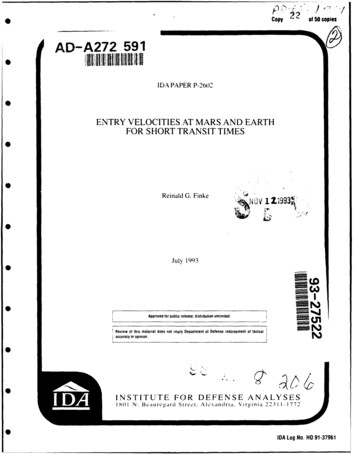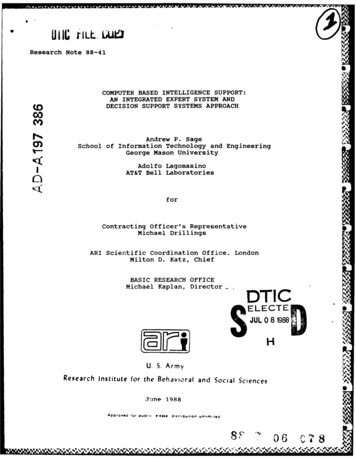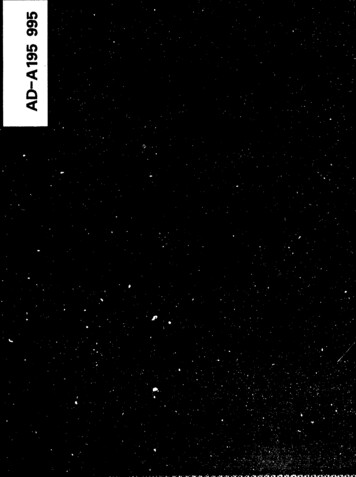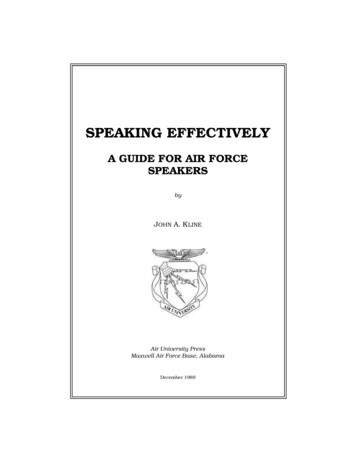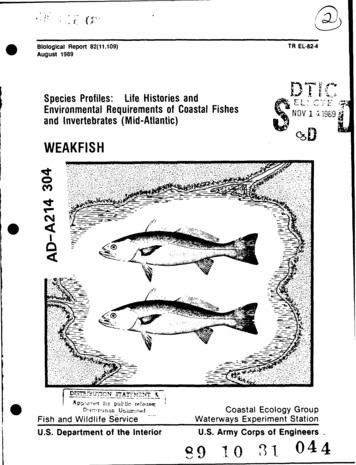
Transcription
**BiologicalV*TR EL-82-4Report 82(11.109)August 1989I SpeciesProfiles:Life Histories andEnvironmental Requirements of Coastal Fishesand Invertebrates (Mid-Atlantic) i!rV kNOV 1-1,989J WEAKFISHcv LcAp ooeJcr pu Llic rp!ease!D'." uo A dCoastalEcology GroupFish and Wildlife ServiceU.S. Department of the InteriorWaterways Experiment StationU.S. Army Corps of EngineersQ , i-o)2i1-04 4
Biological Report 82(11.109)TR EL-82-4August 1989Species Profiles: Life Histories and Environmental Requirementsof Coastal Fishes and Invertebrates (Mid-Atlantic)WEAKFISHbyLinda P. MercerNorth Carolina Divisionof Marine FisheriesMorehead City, NC 28557Project OfficerDavid MoranU.S. Fish and Wildlife ServiceNational Wetlands Research Center1010 Gause BoulevardSlidell, LA 70458Performed forCoastal Ecology GroupU.S. Army Corps of EngineersWaterways Experiment StationVicksburg, MS 39180andU.S. Department of InteriorFish and Wildlife ServiceResearch and DevelopmentNational Wetlands Research CenterWashington, DC 20240
PREFACEThis species profile is one of a series on coastal aquatic organisms,principally fish, of sport, commercial, or ecological importance. The profilesare designed to provide coastal managers, engineers, and biologists with a briefcomprehensive sketch of the biological characteristics and environmentalrequirements of the species and to describe how populations of the species may beexpected to react to environmental changes caused by coastal development. Eachprofile has sections on taxonomy, life history, ecological role, environmentalrequirements, and eccnomic importance, if applicable.A three-ring binder isused for this series so that new profiles can be added as they are prepared.This project is jointly planned and financed by the U.S. Army Corps of Engineersand the U.S. Fish and Wildlife Servi:-.Millikin and Williams(1984) previously published a review of thenomenclature, taxonomy, morphology, distribution, life history, populationstructure and dynamics, and the fishery of the blue crab.Suggestions or questions regarding this report should be directed to one of thefollowing addre ses.Information Transfer SpecialistNational Wetlands Research CenterU.S. Fish and Wildlife ServiceNASA-Slidell Computer Complex1010 Gause BoulevardSlidell, LA 70458orU.S. Army Engineer Waterways Experiment StationAttention: WESER-CPost Office Box 631Vicksburg, MS 39180.,.J,DstiiiA,. A:.D!EtA-SV. .
CONVERSION FACTORSMetric to U.S. CustomaryByMultiplyTo Obtainmillimeters (mm)centimeters (cm)0.029370.3937inchesinchesmeters (m)meters (m)3.2810.5468feetfathomskilometers (km)kilometers (km0.62140.5390statute milesnautica! ,,,L10.760.38612.471square feetsquareacres milessquare meters (m2 )square(km2 )hectareskilometers(ha)liters (I)cubic meters (icubic meters30.2642)(in)milligrams (mg)grams (g)kilograms (kg)metric tons (t)metric tons (t)gallons35.310.0008110cubic esouncespoundspoundsshort tonskilocalories (kcal)3.968British thermal unitsCelsius degrees (0C)1.8(0C) 32Fahrenheit degreesU.S. Customary to Metricinchesinchesfeet (ft)fathomsstatute miles (mi)nautical miles (nmi)25.402.540.30481.8291.6091.852square feet (ft2 )square miles etersmeterskilometerskilometerssquare meterssquarehectareskilometersgallons (gal)cubic feet (ft3)acre-feet3.7850.028311233.0literscubic meterscubic metersounces (oz)ounces (oz)pounds (Ib)pounds (Ib)short tons skilogramsmetric tonsmetric tonsBritish thermal units (Btu)Fahrenheit degrees ( F)0.25200.5556 (F - 32)ivkilocaloriesCelsius degrees
CONTENTSP giPREFACE . .CONVERSION TABLE. . . vACKNOWLEDGMENTS. . . . . . . .NOMENCLATURE/TAXONOMY/RANGE. . . . . .MORPHOLOGY/IDENTIFICATION AIDS. . . .REASON FOR INCLU SION IN THE SERIES. . . 2. 2LIFE HISTORY .Spawning. . . 2Fecundity. . . . . . .arvae . . .3,Juveniles. . . 3Adults . .4.GROWTH CHARACTERISTITCS . .COMMLRCIAL AND RECREATIONAL FISHERIES . . . 9ECOLOGICAL ROLE. .Food habits.9Community Ecology. . .10Diseases . . . 10ENVIRONMENTAL REQLIREMENTS. . . 10Temperature. . . 10Salnit. . .11Uissoiveo, Oxygen . . .11Pollution . . . 11LL ERATURL CITED. . . 13v
ACKNOWLEDGMENTSI am gratefulto Stuart WiIK and Tony Pacheco of the National MarineFisheries Service, Sandy Hook, New Jersey, for their reviews of the manuscript andhelpful suggestions.Vi
0.Figure 1.Weakfish (Cynoscion regalis)(from Goode c name .regalisPreferred common name . . .Leim and Scott 1966; Struhsaker1969;Weinstein and Yerger 1976;Chao 1978). They are most abundantfrom North Carolina to New York(Figure 2).Cynoscion. Weakfish(Figure 1)Other common names . . . . Gray trout,squeteague, sea trout, trout, tiderunnerClass . OsteichthyesOraer . PerciformesFamily . . SciaenidaeMORPHOLOGY/IDENTIFICATION AIDSThe following description is that ofJohnson (1978), summarized from Jordanand Evermann (1896), Eigenmann (1901),HildebrandandSchroeder(1928),Ginsburg (1929),Perlmutter (1939),Massmann (1963), Tagatz (1967), Millerand Jorgenson (1973), and Chao (1978).Geographical range. Weakfishoccur along the Atlantic coast ofthe United States from southernFloridatoMassachusettsBay,straying occasiorally to Nova Scotia and into the eastern Gulf ofMexico (Goode 1884; Hildebrand andSchroeder 1928; Bigelow and Schroeder 1953; Guest and Gunter 1958;0Dorsal rays 24-29, modally 27. Analrays 10-13, modally 12. Vertebrae 25.Gill rakers 4-5 upper,1O-12 lower, andtypically 5 12.A pair of largec.,,ine-like teeth at the tip of upper1
:jvand a row of distinctly enlargedBody elcnteet0 in the lower jaw.Headcompressed.gate,moderately-.NH,MAMouth large.long. snout pointed.oblique, lower jaw projecting, ma'illaryreaching to posterior margin ofDorsal fin with apupil or beyond.the spinous anddeep notch betweenCaudal emarginate insoft portions.,CT.fNYindividuals less than 300 mm totallength (TL).Color dark olive greensidesandbacktheabove withpurple,withburnishedvariouslylavender, green, blue, gold or copper,and marked with a large number ofappear asdark spots whichsmallrunning along bcaieoblique streaksline.Lowerabovelateralrowssurface forward to tip of jaw -4finsthedusky,loweredgePelvic and analyellowish at base.fin olive onfins yellow; pectoralouter side, usually yellow on innerside.NCREASON FOR INCLUSION IN THE SERIESThe weakfish is one of the mostabundant fishes in the estuarine andnearshore waters of the Atlantic coast(Wilk 1979).It is a valuable recreat-onal species and a major componenthaulof the gill-net, pound-net,seine, and trawl fisheries alcng thecoast (Hildebrand and Schroeder 192S:GAWilk 1981).,FLWLIFE HISTORY.'SpawningWeakfish':yureZ.Periods of high landingshave generally been followed by suddenandprecipitous declines in catch,the causes of which are not known.and habitat ecauses.matureatage I through-out their geographic range, however,length at maturity differs betweennorthern weakfish (Delaware Bay andnorth) and weakfish from North Caro-Generaldistr'butior ct -heeakfish along the Atlartic coast ofthe United States (from Wilk 1976).2
ira .Inr northern f ish,femal esmatureo at. :156 mm and males at 251 mmiTL ('Shepherd and Gr imes 1984):inNort*h Ca rolIi na f emalIes spalvned at ?30irli and malIe,; at 180 mm TL (Merriner1 6 ) .GrimesWeaktishspawnin therrandnea rsho recc U1,djt'it-A tes of f etud Ity f or southernwed f Kb diff er from- those for tri hfrlAr h Newr York Fiqhc.A Wea kt ishcll Tv from North Larm Iina proucedL.0I . (53 ova, wvhocrcs a northern fishia!7 c Imle n qth prodIu ced onlIy,)o6. Iova Morr i rer 1976: ShepherdarC'rE,jrtimps19841) .Th11ogci-.l-- p s hLe twcP.ntecunc i ty (f),tca,di eI- qth(S )in m IIimostaIaKLegh nIIwr 'we qhWIc g names, andI gut"''w-,h10) rramrs. wihere hr, isin vJ rollogqarIiLITm aind rs, thefte L ofdc e r w naIt icn .weefo,qkthIrIan rrkKirrr nc r i 9'6 2./f15Inthe New York bight (Shepherd1984 ).- -16.32r rn F4 .6%,I n TL119 75 I1.54 2 inr-0.239l.The embryolugy and larval cevelIoprnent of 6eakfish wyere tcscribed 1)yWelshanidBreder (19"31),parson(1941). Harmi c ( 1958)Scott-on et alI(1973) , JppscinnoMo ran(19;;14).,Johnson (1/8,nd Powles and Stencier(1918).Hatch inocc urIsi3-4It Chours atC 'Welsh arcd Breder1923) . Weak fish larvae rangle trom 1.5to 1.1/5 mr. TI at. hatch,nq ano beccmedeiersal by S mm -,.(Welsh andi Bin der1923;, Pearson 1941).Weikfish larvaehavebeerco 1 eo tedI,nedr-shorewaters to 10 Fon Oftshore in co)astalichthyoplankton surveysBerri pr eta] .178)ALvPII i 1esThe use ofostt acareeia,snursery grounds. by we aN' t s,hswe 1doculiented Julven iI E- a I e0( tenIt freq(uenl I'I iaw drip I1- Cc,cfthe d,-;,,.-I , ')1-, rdronsthethar in 1 hea i hricn 1orc t crfcom shoalI a roav:I ey19,39: KMsI! e Lc al19 56n-N!ILa:19l6l,1 4aP - hatnds-ar1dI"tagna1Ih7ot0)C (hoas 19/1Cha o arnu ck1,1/7)sAw pi n c:tNom ttlrti0.6 .64,) In Tn 11shwe rn resib.yt heur- .ofqM -ir ir,drILi r y it' dShay , c, Ila, ;,A enrk.aIrIleat,amaereasNo r*.harc 'rahc ei s, ccrOfk ta yI CV4loarroc', hamaauer-aou I'd s e1).85W;c.2In,An! t1-.tuar:!ne areas, ot the coast. aftert he spy iginshorp migraton (WelshandLB r ede r1923 HilidebrandandSchroedjer 1928).Ihe spawning seasonof we-.kt ish Ks earl 'en and somewhat21orqetn North CarolI i ia than in a reasto the north; t extends from March toSeptemher. and peaks from April toJulne (Merniner 1916).In,the New Yorkbig ht "'Delaware Bay to New York ), the,eascin tctends trom May to mi-d-Julyit'' hepherdanidGrimes1984) .Iwospawn inripeaksarereportedforwea kfti sh 41n New York Bight estuaries:the earl icr mid-Nay peak, attributedtoc the largest individuals or "tidernners," is fol lowed Lv a June peakdevelo ped by smaller fish (Shepherdarc 6r oes 198-4).?1,198 1,279atito'rI
zd by mouerdte depths , 'SI hlhigher, sal-rit'es, and presence cfsand. and/or sanc-grass bottoms) ratherthan -'lprimary nursery areas (shallowtributaries of 'iow s aIi r ;ty anid mudand/or mud-grass bottdm) (SpitsbergenInr1976).and Wol ff 1974 ; PuBayRIDelIawareandBayChesapeakejuvenwle weakfish migrate from hgh tolow sai rity areas throughout' thesummer, return to high salinity waters'n fallI, art 'leave the estuaries bykHi dleirand and SchroederDecember1928; Massmanr et a] . 1958; 7homas1971-, Chao and Mus-Ick 1977).'juven ;IealonigareW( dkf hMNH4VACT.7NNNdistributed-DWEthe coast fromiogsland toNorth Carol'na at depths of 9-26 m :rIate Summer and f all (CIatk et a]l1969).oung-of-the--yeaivoeakf "shVAviere caught : o0ce an trdwlI surCey SalIonq the coast of North Cadrclia 'r1968-t981 at depths of 9-18 m dur ngtallarc, wiinter,andf romNorthCaroI na to FlIori da it.depths of 9- 11m 'Irwwrter and early spring WileK S ;Iiver-man 19 76.utIbetw-eenNNvi a kfish migrate seasonallyinshore and offshore waters,Welsh and breder 1923; fMerriner 1973:,WarmingW-fIlk 1976. 19719, 1980').coa:,tal '.aiterIs Il spring promptsifishore arid northerlyigrationadult- from their winter ng groundsofanoftoGA(Figureinshorecongregateflr thesounds, bays, ai'o eStuaries3).The larger fish move---f irst and t end tonorthern part of the range 1Wi I anidSilverman 1976; WilIk et a]l.19N')Catch recirds from the pound-niet andhaul-seine hsheries -In Delaware Bay,.- Chosapeake Bay ,andPaml icoS)nunoinrd ' ate that the large fsh are folloriec by a second group of smallerWeaKfs'hin1 sumrI(HigginsandPedrson1928:M.,as sman n 1963:anid Smith 1971: Sholar1980.1931 ).Shortly19719;-FLDaibenDeViesaftertheir'rit al appearance, weakfsh return tothe larger bays and possibly to theocean to spawn. :fi northern areas ai gujre 3.l1verents of the vqpakfishalong the Atlantic coas, tofthe riteoStates during sprinq and su-mner (fromWilk 1976 ).4
qr.- ater, prop Ort ionr of the 3 (1Ulr s SpendIaerather thanthe summer roceanr%A[in e-.tuaries A,,f ail1vi Letntts en pera tuoLIEmcve offshoret ormCiCCI Ileaqreoa-t ur)s1darid generallIy soul-hwia rdkalong the coast (Nesb 4t 175,4.et a!198Ta;mnWilIcK 17:i 1k(Figure 4).he C rs'-verm an 1916 )nensal ShelIf from Chesapeake Ba y t oCape Lockout, NCI',appears t-o[h,themajor- w'Interig ground for weaKfish. Astudy of the wirter t-rawl fish ery iffthe V rg ria and North Carol ira coastsindicated that most vNeakf ish we recaught iInthe southerr t irqI ,ar1eabetween Ocracoker Iet ano B ) doI-,i ano , NC . atcepths cof 18-55:) mSome weakf sh rray(Pearson 193 ).rema irno shore waters thruughoutthewi terfromCrt hCarolinasouthward (Goode 1384: ri igg 4n s andPearIs on 1928 , Hildetrarc and Ca blIeNJMIDE,]1934) .NcGROWTH CHARACTERISTICSWeaKfiShorowthis Particularlyrapid during the first year. In Delaware Bay. juveniles may grow from 20to 35 mmr/month durg June-Septemiber1:chtryologicalAssoc ates 198C) ano,fray attain, lengths ranging from 1CC. to175 mm 7L *hroughout the range.[hevariabilityaof sizes with in yearclass es results from ,-heextenceCspawn i rg season.MassmatrPt a l(1956) and Thomas ( 19; 1) founod twodis t-Inct size groups of young-of-theyear weakfish i n fal
and Invertebrates (Mid-Atlantic) WEAKFISH cv Lc Ap ooe J cr pu Llic rp!ease! D'." uo A dCoastal Ecology Group Fish and Wildlife Service Waterways Experiment Station U.S. Department of the Interior U.S. Army Corps of Engineers Q_, i-o ) 2i1- 04 4. Biological Report 82(11.109) TR EL-82-4 August 1989 Species Profiles: Life Histories and Environmental Requirements of Coastal Fishes and .Cited by: 4Publish Year: 1989Author: Linda P Mercer

